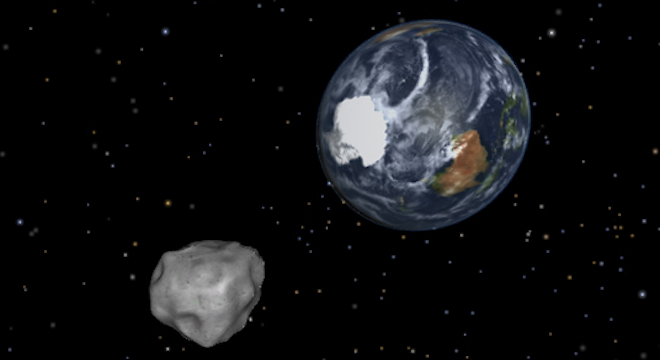It’s definitely not “Armageddon.” But an asteroid measuring 150 feet in diameter with a mass of 130,000 metric tons will make the closest pass of Earth for an object of its size on February 15, 2013, traveling about 17,450 miles-per-hour (4.8 miles-per-second), NASA noted on Thursday.
The asteroid’s pass will be a “record predicted close approach for a known object of this size,” said Donald Yeomans, manager of the NASA Jet Propulsion Laboratory’s Near-Earth Object Programs Office, in a press conference streamed live on NASA’s website on Thursday.
Yeomans said the asteroid, dubbed 2012 DA14, would come anywhere between within 17,100 miles and 17,200 miles of Earth’s surface, well far away enough to avoid any potential collision with our homeworld.
“No Earth impact is possible,” Yeomans clarified during NASA’s press conference. Here’s a NASA Sciencecast video explaining the approach and NASA’s Near Earth Object Programs Office:
But it will come much closer — within 500 miles — of communications and weather satellites in geosynchronous orbit (around the Earth).
Here’s a NASA video animation simulating the flyby (there is no sound). It and additional animations can be found here:
The asteroid is not expected to cause any damage to these satellites, either, but scientists said they were working with satellite operators to monitor the situation.
The asteroid passage is cause for excitement in the scientific and spacewatching communities, not only for its historic significance, but because it will provide scientists with a-once-in-a-generation opportunity to study a near-Earth object more closely using radar imagery. Specifically, the Goldstone Solar System Radar in California’s Mojave Desert will attempt to image the asteroid in the days following its passage.
“One would expect an object to get this close every 40 years and for there to be a collision with Earth every 12,000 years,” Yeomans added.
Though there’s no danger of a collision this time, scientists do have an idea of what an asteroid impact of this size and speed would have on Earth’s surface because one slightly smaller, an estimated 120-feet across, entered the planet’s atmosphere and detonated in the sky above uninhabited Siberia, Russia, in 1908, where it split in two large pieces. When the debris hit the surface, they caused a seismic shockwave that killed hundreds of reindeer and flattened millions of trees, and the impact sent up a dense ash cloud that blanketed the sky for miles. That event was known as the “Tunguska impact,” named after a nearby river.
Scientists passed up the opportunity to answer just what would happen if a similarly sized object impacted in a populated area.
That said, NASA does hope to learn more about near Earth asteroids and potentially avoid any collision events in the future, or at least prepare for them, from a new mission set to launch in 2016.
That mission, called the “Osiris REx,” involves sending an unmanned space probe to another near-earth asteroid, 1999-RQ86, to collect and return to Earth a sample. It would be the largest such collection of space material brought back to terra firma since the Apollo missions, according to Edward Beshore, deputy principal investigator of the mission and an astronomer at the University of Arizona.
Check out a NASA video animation simulating that mission (also no sound):
“We will carefully approach the asteroid to obtain the sample and return it to earth in 2023,” Beshore said during the press conference.
However, completing that mission successfully will be a substantial challenge for NASA and other planetary scientists involved. Attaching the Osiris REX probe to the asteroid will be a tenuous affair because the gravity around the asteroid is so weak that the force of sunlight acting on the probe will be comparable and cause the probe to effectively “sway” like a sailboat in the wind, as Beshore described it.
NASA still has several years to figure out how best to affix that craft to its near-earth asteroid, however.
As for the upcoming flyby asteroid 2012 DA14, it should “be observable in dark sky from Eastern Europe, Asia and Australia” using a small telescope, Yeomans said.
The asteroid was first spotted almost a year ago on February 23, 2012 by scientists working at an observatory in Mallorca, Spain.






